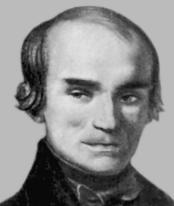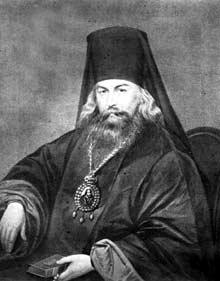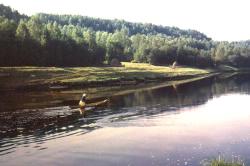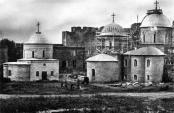Articles
/
Holy Trinity Monastery of St. Aleksandr of Svir, the
Holy Trinity Monastery of St. Aleksandr of Svir, the
Subject /
Religion. Church/Monasteries and convents
The Holy Trinity Monastery of St. Alexander of Svir (the village of Staraya Sloboda/ Svirskoye, the Lodeynoye Pole district). The monastery was founded by Venerable Alexander Svirsky. In 1484 he settled in a forest area nearby the Svir River in the coast of Roshchinsky Lake. A monastic community was formed after coming his followers (Venerable Adrian Andrusovsky, Venerable Athanasius Syandemsky, Venerable Gennadius Vazheozersky and Venerable Nicephorus Vazheozersky, Venerable Gennadius Kostromskoy and others). In 1508 a remote monastery was established nearby (Venerable Alexander was buried there in the brotherhood cemetery in 1533). Soon the wooden Trinity Cathedral, the Cathedral of the Transfiguration of Christ, the Cathedral of St. Nicholas were built. During being a hegumen of the monastery Venerable Alexander the construction of the stone church of the Intercession of the Holy Virgin was started. This single-domed church without inner columns with a refectory is the most survived monastery constructions. Rich donations to the monastery were sent by Tsars Ioann IV, Fiodor Ioannovich, Boris Godunov. During the Troubled Times the monastery was brought to ruin three times; It was restored with the assistance of the kingly nun Martha. In 1644 the stone Cathedral of the Transfiguration of Christ was built in the former remote monastery. The church of St. Zechariah and St. Elizabeth was built to the southern façade of the cathedral, in 1716 the side-altar of Venerable Alexander Svirsky was buit to the northern façade. The multy-domed bell tower of the Trinity part of the monastery was built up anew between 1647 and 1674. Under archimandrite Hermogenes (1673-1699) the monastery became the centre of management of the Olonets region. A Stone wall made of two-storied buildings with a ditch from the outside (the circumference 525 metres) was built in 1677-1690. The dilapidated cathedral of the Trinity was demolished in 1694-1697 and the new temple was built. The temple on the high basement was surrounded with a gallery from three sides. Its architectural appearance combines features of the Novgorod and Moscow architectural schools. In 1708-1715 the temple was painted by Leonty Markov and his friends (the temple survived). The infirmary church of St. John of Damascus was built to the north of the monastery in 1716. The Monastery was a prominent landowner in the region of Mezhozerye (there were 34 villages). 27 communities of monks were joined to the monastery in 1723. Since 1817 the monastery became the centre of the eldership. In 1873-1874 the Cathedral of the Transfiguration of Christ was enlarged. The new prosperity of the monastery was connected with archimandrite Agathangelus (Amosov). In 1903-1904 the bell tower of the Transfiguration part was constructed (to the design of the civil engineer S.M. Belyakov). In 1915 a church in a scete in the northern coast of the lake was consecrated, in 1917 a church on the pier was consecrated. By 1917 the monastery became the first class dormitory monastery, 109 people lived there, it owned six thousand hectares of land. In 1918 the monastery was brought to ruin, for the first time in Russia the official opening of the holy relics was made. In 1919 the monastery was closed, in 1925 churches were closed (the scete church was closed in 1933); the inner decoration and bells were lost. Since 1927 a labour settlement was placed there, since 1956 to the pesent day a mental hospital is placed in cells of the Trinity part of the monastery. All constructions on the pier and churches in the scete were destroyed. In 1997 the monastery was officially passed to the Russian Orthodox Church, in 1998 the holy relics of Venerable Alexander Svirsky were returned. After the repair work public worships were begun in the side-chapel of St. Zachariah (now the collection of icons of the 16th - early 20th century was placed there), since 2001public worships has been begun in the Cathedral of the Transfiguration and in 2005 they were started in the refectory church of the Patronage of the Mother of God. The superior of the monastery is Archimandrite lucian (Kutsenko). The historic city residence of the monastery in St. Petersburg (1 Borovaya Street) was completely rebuilt; since 2000 the new monastery city residence (10 Cheliyev Street) with the church of the Nativity of Christ has been working. Since 1998 the monastery city residence with the church of St. Nicholas has been working in the settlement of Svirstroy.
Authors
Bertash, Aleksandr Vitalyevich
Persons
Adrian Andrusovsky (Andrey Zavalishin), St.
Afanasy Syandemsky, St.
Agafangel (Amosov)
Aleksandr Svirsky, St.
Belyakov, Semyon Matveyevich
Boris Godunov, Tsar
Fiodor Ioannovich, Tsar
Gennady of Kostroma and Lyubimograd, St.
Gennady Vazheozersky, St.
Ioann IV, Tsar
Lukian (Kutsenko), archimandrite
Marfa ( K.R. Romanova), nun
Nikifor Vazheozersky, St.
Popov, Leonty Markov
Yermogen, archimandrite
Geography
Saint-Petersburg City/Borovaya Street
Saint-Petersburg City/Cheliyev Lane
Topographical landmarks/Roshchinskoye Lake
Leningrad Oblast, the/Lodeynoye Pole District/Staraya Sloboda Village
Topographical landmarks/Svir River, the
Leningrad Oblast, the/Lodeynoye Pole District/Svirstroy Urban Settlement
Bibliography
Ивановский Я. И. Свято-Троицкий Александро-Свирский монастырь. СПб., 1901
Святой преподобный Александр Свирский. М., 2003
Свирский патерик / Авт.-сост. иеромонах Нестор (Кумыш). СПб., 2004.
Mentioned in articles:
|
hidden
|
Berednikov, Yakov Ivanovich (1793-1854), a scientist
Berednikov, Yakov Ivanovich (1793-1854, Tikhvin), a poet, archive manager, historian, academician of the St. Petersburg Academy of Sciences (1841). Berdnikov spent his childhood in Tikhvin Town where his parents lived. He graduated the Tikhvin... more
|
|
|
|
hidden
|
Eparhy of Olonets and Kargopol
The Eparchy of Olonets and Kargopol. Othodox monasteries and churches of the Olonets region (the territories of present-day Korelia, partly of the Vologda and Leningrad Regions) were originally included into the Eparchy of Novgorod. The foundation... more
|
|
|
hidden
|
Fyodor (Fyodor Ilyuch Polzikov) (1756-1822), clergy figure, schemamonk
Fyodor (Fyodor Ilyuch Polzikov; Filimon after taking of monastic vows; 1756-1822), a schemamonk, a zealot of godliness. In 1782 Fyodor went into a monastery in secret from his family, in 1784 he was taken the monastic vows by Venerable Paisius... more
|
|
|
hidden
|
Ignaty (Bryanchaninov) (1807-1867), sainted hierach, clergy figure
Ignaty (Dmitry Aleksandrovich Bryanchaninov; 1807-1867), an ecclesiastical writer, theologian, sainted hierach. Dmitry Aleksandrovich Bryanchaninov studied in the Main Engineering College in St. Petersburg from 1822 untill 1827. He was in the first... more
|
|
|
|
hidden
|
Lodeynoye Pole District
LODEYNOYE POLE DISTRICT, a part of Leningrad Oblast located east of Lake Ladoga in the Svir River basin. In the north-west and north, it borders Olonets District of the Republic of Karelia; in the north-east and east, Podporozhye District; in the... more
|
|
|
|
hidden
|
Makary (1482-1563), metropolitan, clergy figure
Makary (1482–1563), metropolitan of Moscow and All Russia, spiritual writer, in the world в миру he was Mikhail Leontyevich. He was professed as a monk during his yoth in the Pafnuty-Borovskoy Monastery. From 1523 he was the archimandrite of the... more
|
|
|
hidden
|
Orthodox monasteries
The Othodox monasteries. The oldest monasteries located on the territory of the Leningrad Oblast - the Monastery of the Dormition, the Monastery of St. Nicholas the Wonderworker and the Zastenny Monastery of St. George in Ladoga were founded... more
|
|
|
|
hidden
|
Restoration of buildings of architectural and historic interest.
Restoration of buildings of architectural and historic interest. The first experience of the research restoration of the Russian Middle Ages monuments in the territory of the pesent-day Leningrad Oblast dates from 1846-1847, when in the Ivangorod... more
|
|
|
|
hidden
|
Svir River, the
SVIR, a river in the north-east of Leningrad Oblast. Length: 224 km. Average flow rate at the mouth: 780 cu. m/s, catchment area: 84,400 sq. km. It flows from Lake Onega at its south-western end, crosses Podporozhye and Lodeynoye Pole Districts, and... more
|
|
|
|
hidden
|
Zenkov, Semyon Nikolayevich (1877-1941), an artist
ZENKOV, Semyon Nikolayevich (1877, Lyugovichi Village, Olonets Gubernia; modern Lodeinoye Pole District, Leningrad Oblast – 1941), artist. He was born and brought up in a peasant family. He started to learn painting at Aleksandro-Svirsky Trinity... more
|
|
|
|














